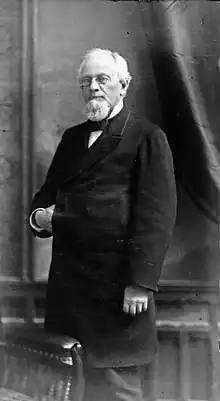Webster Wagner | |
|---|---|
 Wagner shortly before his death in 1882 | |
| Born | October 2, 1817 |
| Died | January 13, 1882 (aged 64) Spuyten Duyvil, Bronx, New York |
| Nationality | American |
| Occupation(s) | Inventor, businessman, politician |
| Years active | 1853-82 |
| Known for | Inventing early railroad sleeper car |
Webster Wagner (October 2, 1817 – January 13, 1882) was an American inventor, manufacturer and politician from New York.
Life
Wagner was born near Palatine Bridge, New York. He developed a wagon-making business with his brother James. The business had folded by 1842, largely due to the Panic of 1837.[1] After serving as an employee for the New York Central Railroad, Wagner invented the sleeping car and luxurious parlor car. He also perfected a system of ventilating railroad cars. His inventions were first used on the NY Central and later spread to other lines. He founded the Wagner Palace Car Company, located in Buffalo, New York. Several legal battles with the Pullman Company failed to put him and his partners out of business; at the time of his death the two companies were completing a merger.
He was married to Susan Davis, and they had five children.
He was a Republican member of the New York State Assembly (Montgomery Co.) in 1871; and of the New York State Senate from 1872 until his death, sitting in the 95th, 96th, 97th, 98th, 99th, 100th, 101st, 102nd (all eight 15th D.), 103rd, 104th and 105th New York State Legislatures (all three 18th D.). He was killed in a rail accident while returning from Albany to New York City when two trains of the New York Central and Hudson River Railroad collided in between the Kingsbridge and Spuyten Duyvil stations in The Bronx, two weeks into his sixth Senate term, on January 13, 1882. His body was found crushed between two of his company's cars.[2]
The Webster Wagner House at Palatine Bridge was added to the National Register of Historic Places in 1973.[3]
See also
- List of inventors killed by their own invention
- Rail Car Grand Isle: A preserved Wagner Palace car
Notes
- ↑ "Webster Wagner Wagon-making Papers, 1837-1842 (finding aid)". New York State Library Website. New York State Library. Retrieved 5 January 2016.
- ↑ "Meeting a Terrible Fate – Nine Persons Crushed and Burned in a Collision – A Train Crashing Into the Rear of the Atlantic Express – Nine, Perhaps Twelve, Victims Caught in the Burning Cars – State Senator Wagner Among the Dead – Narrow Escape of Many Others – Terrible Scene at the Wreck". New York Times. January 14, 1882. p. 1. Retrieved 16 October 2016.
- ↑ "National Register Information System". National Register of Historic Places. National Park Service. March 13, 2009.
References
- White, John H. Jr. (Spring 1986). "America's Most Noteworthy Railroaders". Railroad History. 154: 9–15. ISSN 0090-7847. JSTOR 43523785. OCLC 1785797.
External links
- Webster Palace Car Company
- Accident at Spuyten Duyvil
- . Appletons' Cyclopædia of American Biography. 1889.
- Finding Aid to Webster Wagner Wagon-making Papers, 1837-1842 at the New York State Library, accessed January 5, 2016